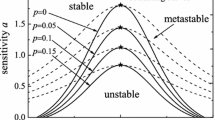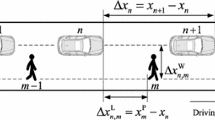Abstract
Car following model is one of microscopic models for describing traffic flow. Through linear stability analysis, the neutral stability lines and the critical points are obtained for the different types of car following models and two modified models. The singular perturbation method has been used to derive various nonlinear wave equations, such as the Korteweg-de-Vries (KdV) equation and the modified Korteweg-de-Vries (mKdV) equation, which could describe different density waves occurring in traffic flows under certain conditions. These density waves are mainly employed to depict the formation of traffic jams in the congested traffic flow. The general soliton solutions are given for the different types of car following models, and the results have been used to the modified models efficiently.
Similar content being viewed by others
References
Nagatani T. The physics of traffic jams [J]. Rep Prog Phys, 2002, 65(9): 1331–1386.
Chowdhury D, Santen L, Schadschneider A. Statistical physics of vehicular traffic and some related systems [J]. Phys Rep, 2000, 329(4): 199–329.
Komatsu T, Sasa S. Kink solution charactering traffic congestion [J]. Phys Rev E, 1995, 52(5): 5574–5582.
Nagatani T. Stabilization and enhancement of traffic flow by the next-nearest-neighbor interaction [J]. Phys Rev E, 1999, 60(6): 6395–6401.
Masakuni M, Nagatani T. Soliton and kink jams in traffic flow with open boundaries [J]. Phys Rev E, 1999, 60(1): 180–187.
NAGATANI T. Density waves in traffic flow [J]. Phys Rev E, 2000, 61(4): 3564–3570.
Ge H X, Cheng R J, Dai S Q. KdV and kink-artikink solitons in car following models [J]. Physica A, 2005, 357(3–4): 466–476.
Newell G F. Nonlinear effects in the dynamics of car following [J]. Oper Res Phys, 1961, 9(2): 209–229.
Whitham G B. Exact solutions for a discrete system arising in traffic flow [J]. Proc R Soc London, Ser A, 1990, 428(1874): 49–69.
Bando M, Hasebe K, Nakayama A, et al. Dynamical model of traffic congestion and numerical simulation [J]. Phys Rev E, 1995, 51(2): 1035–1042.
Nagatani T, Nakanishi K, Emmerich H. Phase transition in a difference equation model of traffic flow [J]. J Phys A, 1998, 31: 5431–5438.
Nagatani T. Thermodynamic theory for the jamming transition in traffic flow [J]. Phys Rev E, 1998, 58(4): 4271–4276.
Nayfeh A H. Introduction to perturbation technique [M]. New York: John Wiley & Sons, 1981.
Ge H X, Cheng R J, Li Z P. Two velocity difference model for a car following theory [J]. Physica A, 2008, 387(21): 5239–5245.
Ge H X, Dai S Q, Dong L Y, et al. Stabilization effect of traffic flow in an extended car-following model based on an intelligent transportation system application [J]. Phys Rev E, 2004, 70(6): 066134.
Ge H X, Dai S Q, Dong L Y. An extended carfollowing model based on intelligent transportation system application [J]. Physica A, 2006, 365(2): 543–548.
Ge H X, Zhu H B, Dai S Q. Effect of looking backward on traffic flow in a cooperative driving car following model [J]. Eur Phys J B, 2006, 54(4): 503–507.
Author information
Authors and Affiliations
Corresponding author
Additional information
(Communicated by NI Ming-kang)
Project supported by the National Basic Research Program of China (Grant No.2006CB705500), the National Natural Science Foundation of China (Grant Nos.10532060, 10602025, 10802042), and the Natural Science Foundation of Ningbo (Grant No.2007A610050)
About this article
Cite this article
Shen, Fy., Ge, Hx. & Lei, L. Application of singular perturbation method in analyzing traffic density waves. J. Shanghai Univ.(Engl. Ed.) 13, 6–11 (2009). https://doi.org/10.1007/s11741-009-0102-3
Received:
Revised:
Published:
Issue Date:
DOI: https://doi.org/10.1007/s11741-009-0102-3
Keywords
- traffic flow
- singular perturbation method
- car following models
- Korteweg-de-Vries (KdV) equations
- modified Korteweg-de-Vries (mKdV) equations




